|
|
 |
|
|
 |
Historic Tokyo 東京の史的
Japan is a country of contrasts and to the westerner's
eye they seem to contradict themselves; they honor tradition while advancing technology, they respect nature and
love robots, they like to work hard and...uh...play...er no....work hard. Why is that?
Anyway, in Tokyo you're likely to find beautiful
temples, shrines and palaces right next to noisy pachinko parlors and glass skyscrapers. Probably the
biggest surprise is that the noisy pachinko parlor won't be heard in the sacred temple and the sacred temple won't even be
noticed in the noisy pachinko parlor. Although they live side by side, they couldn't be more of a world apart.
For this reason, and because you may never get a better opportunity to see a culture so untouched by the western world,
it really is worth it to check out a bit of old Tokyo while you're there.
There was so much to see that it's been broken
down into two pages, this page is mostly historical sites that are connected to people (sumo, geisha, samurai/ronin) and page
two is connected to places click here to go to page 2
(pronounced Ah-sah-koo-sah sen-soh-jee) ("ji" means
temple)
Old Asakusa Sensoji picture taken circa 1880's-1890s.
Asakusa Senso-ji (sometimes referred to as Asakusa Kannon
or Asakusa Temple) is probably the most touristy of the temples, but is worth checking out as it's the oldest temple
in Tokyo.
When you first get there you'll pass under the biggest
paper lantern you've likely seen at Kaminarimon 雷門,(Thunder Gate). On either side of the gate are two guardians
Raijin (God of Thunder) pictured below on the left and Fujin (God of Wind) on the right.

Once
through the gate, you'll find yourself taking part in one of the oldest traditions of all buddhist temples....shopping.
Yes, vendors have lined the sides of this walkway since 645 AD when this temple was originally built (it's been burned to
the ground and rebuilt several times since then). Now as then, vendors sell local souvenirs and snacks to
passers-by who've likely come to the temple to make a donation and happen to have a little spending cash in their pocket.
Nakamise Dori - (shopping street at Asakusa Sensoji)
After walking through Nakamise Dori you'll arrive at
the main gate to the temple and pagoda. The gate is called "Hozomon" and is also the building shown in the
picture from the 1880s at the top of this page. There are also guardians on either side of this gate, the two muscular
guardians of Buddha are collectively called "Nio". 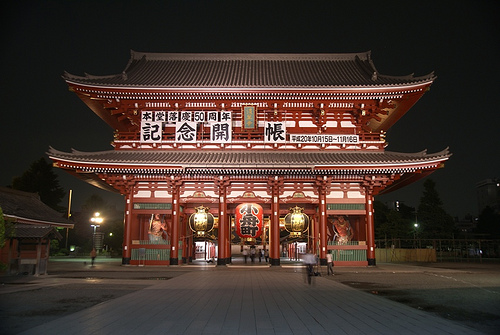
and just through Hozomon gate 宝蔵門 (Treasure house gate) you'll see the actual Temple.

...and to your
left you might be surprised to suddenly see Asakusa's famous five story pagoda.
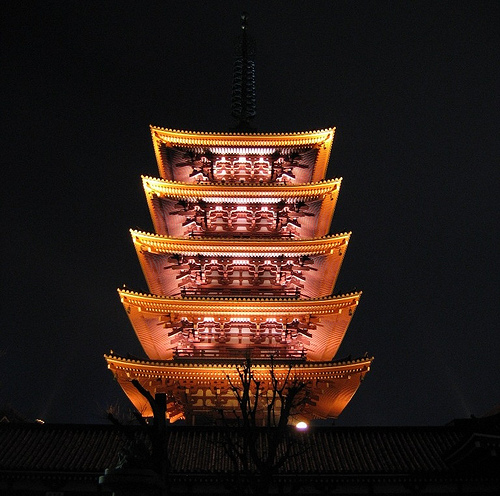
and just behind the temple in an area called "Hana machi"
(literally translated "flower town") or as westerners might call it "Geisha Town".
Geisha
Town
Asakusa Hanamachi 浅草 花街
Photo taken in 1891 of the famous Geisha from Nihombashi, Tokyo, her name
is Tamaye.
Hanamachi 花街 (Flower Street) is an area appointed
with Okiya 置屋 (Geisha Houses), and the Ochaya
お茶屋 (Tea houses) and Ryotei 料亭
(Entertainment restaurants) where Geisha's work.
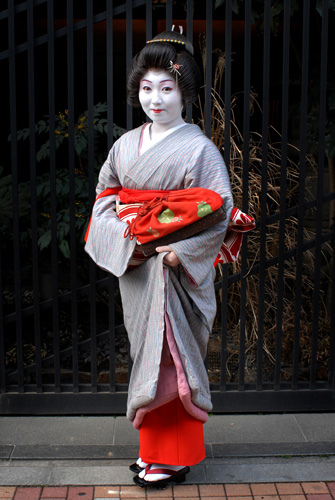 Flower Towns are an excellent place to get pictures of Geisha (no
plural in japanese)at dusk on their way to work at the tea houses. Geisha don't usually wear heavy makeup except for
special performances, if you see a fully made up "geisha" and they're not on a stage or working a festival than you've
most likely seen a "Maiko" . A Maiko is a Geisha in training, the prominent makeup is to make her
appear now as the beautiful woman she will soon become. Asakusa's hanamachi is locally called
"Asakusa Kannonura" which means (Behind Asakusa's Temple), this location is fairly accurate as its about a 5 minute walk from
the actual temple at Asakusa. If you walked through the Thunder Gate, then through Nakamise Street and through Hozomon
Gate to see the temple, you would walk the same direction past the temple until you arrived at a major road, and just across
that road is Asakusa's Hanamachi.
Photo taken in 2007 of the famous Geisha from Asakusa, Tokyo,
her name is Noriye.
If you want to take pics of Geisha, like the pic below or just get
a feel for the area of Asakusa Kannonura it's located a few blocks from the temple's exit, we recommend getting there between
6p-8p to when the Geisha leave for work at the Ryotei.

The map below shows you walking directions to the nearest Geisha House in Asakusa's
Hanamachi.
The address to the Geisha House is 日本, 東京都台東区浅草3丁目33−5,
for a larger map go to http://maps.google.com and copy and paste the japanese address above.
About Geisha
Geisha 芸者 (pronounced
Gay-sha) are highly trained performers, a good western comparison might be the Ziegfeld Girls of early Broadway, these are entertainers who are highly sought
after by wealthy playboys for their talent and beauty. Geisha are usually hired for big company parties and will sit
by their host and engage in interesting conversation, pour drinks, light cigarettes and then join the other Geisha onstage
for a performance that usually includes dancing with fans, and playing a musical instrument. If
a Geisha is popular enough, she'll be asked out several times by the same wealthy man. For the length of her career,
it's illegal for a Geisha to become a mistress or to engage in "relations" with her wealthy clients.

You
can hire a geisha to entertain you at a tea house or restaurant for an hour of her time (approx.
$600) which she will use by engaging in light conversation with you (probably in Japanese), pouring drinks
for you and maybe play a song for you on her Shamisen (japanese guitar) and then it's time for you to go home.
Normally,
you'd also need a introduction to the Ryotei or the Okiya from a regular customer that they know. If you're really interested
in this experience, we recommend asking a Hotel Concierge help you make reservations to be entertained
by a Geisha at a Ryotei.
Of course,
if you know where to find Geisha, you should also know where to find the quintessential Japanese hero, the pride of Japan....the
Sumo wrestler!
Sumo
Town
Ryogoku 両国 (pronounced "Ree-oh-gohk")
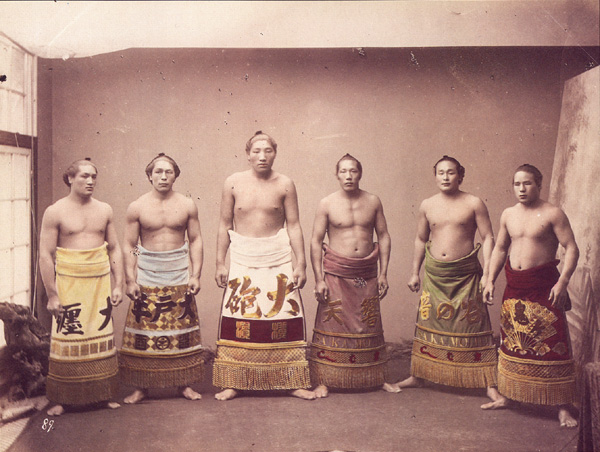
Photo taken in 1889 of six Sumo wrestlers in Japan.
Ryogoku 両国
means "two lands", the area was named after a bridge that was built to span the Sumida river and finally connect
the two lands of Edo and Shimosa. In 1904 a train station was built here and soon thereafter (in 1908)
the Ryogoku Kokugikan 両国 国技館 (Sumo Stadium) and Sumo Heya 相撲 部屋 (Sumo stables) sprang up, giving this area the
nickname of "Sumo Town". 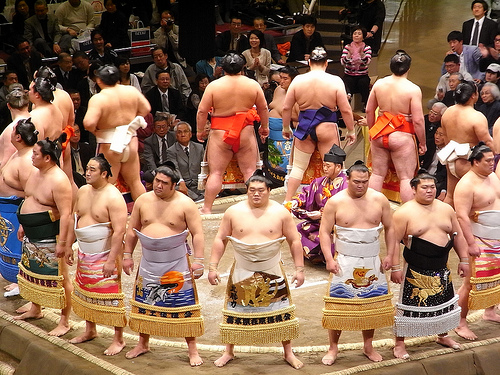
Photo taken in 2008 (118 years after the pic above) of Sumo wrestlers at
Ryogoku Kokugikan (Sumo Stadium) pictured below.
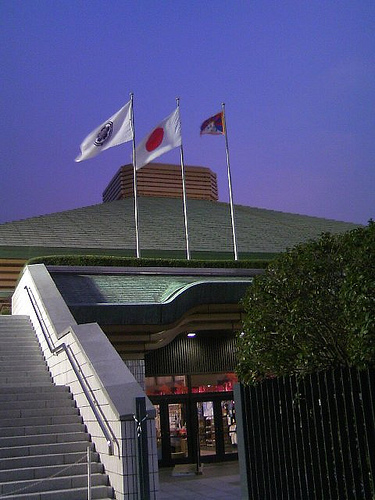
Just two minutes
from the train station and visible from practically everywhere in Ryogoku, the Sumo Stadium hosts three (of the six) annual
Sumo Tournaments in January, May and September and seats 10,000. Please click the picture of Sumo Stadium above
to link to more information on how to get tickets.
It also has a
free Sumo museum (shown below) open to anyone except when a tournament is in progress and the its restricted to ticket holders
of the match. Please click the picture below to connect to the official website for operating hours and location.
If you're interested
in Tokyo's history there's also the free Tokyo-Edo Museum, just east of the stadium, filled with seven stories of fun
models and exhibits dedicated to the Tokyo of yesterday.

Pictured above is the Tokyo Edo Museum entrance and below
is one of the many detailed models depicting Tokyo's history. Click on either picture to link to the official site for
more information.

It's not an odd occurence
to see Sumo just walking around, running errands or picking up lunch on their day off, and c'mon who doesn't want
a shot of a Sumo wrestler in their vacation pics?
Sumo Town is not only home to several Sumo Stables, it has just about everything
for Sumo wrestlers to buy that you can think of. Just east of the Edo Tokyo Museum is a main street (click here for map)with shops carrying oversized clothes, gigantic shoes,
and even restaurants serving Chankonabe ちゃんこ鍋
(pictured below, a staple of the Sumo diet).
Only Sumo wrestlers make
this meal and it's part of the regime that makes a Sumo big, strong, quick and flexible. It's mostly
protein and vegetables and no two chankonabe is alike as it's usually prepared with available ingredients. If you've
ever wondered what walking in a Sumo's giant sandals felt like, then you might want to try some Chankonabe yourself.
There's also a main
street just west of the Stadium (click here for map), where you can take a walk that all Sumo hopefuls take
to Ekoin Shrine (click here for location of Ekoin Shrine), which was the original location of the outdoor Sumo tournaments prior to 1909. A Sumo monument has been
erected on this spot called Chikarazuka力塚, Sumo
apprentice's will come to pray for power and strength from the gods.
This shrine also
serves as a memorial for those unknown victims of the great fire of 1657 and as a shrine for missing
pets and people who died in various calamities.
Probably the most
compelling reason to visit this shrine is that it's a short walking distance from one of the coolest historical markers in
Japan.
The wall to Kira's
mansion (seen below) marks the spot where Lord Kira met his gruesome end on December 14, 1702, following
the attack of the heroic and legendary Forty-Seven Ronin , who avenged their master Lord Asano's death in a plot
that required victory at any cost (click here for the full story). 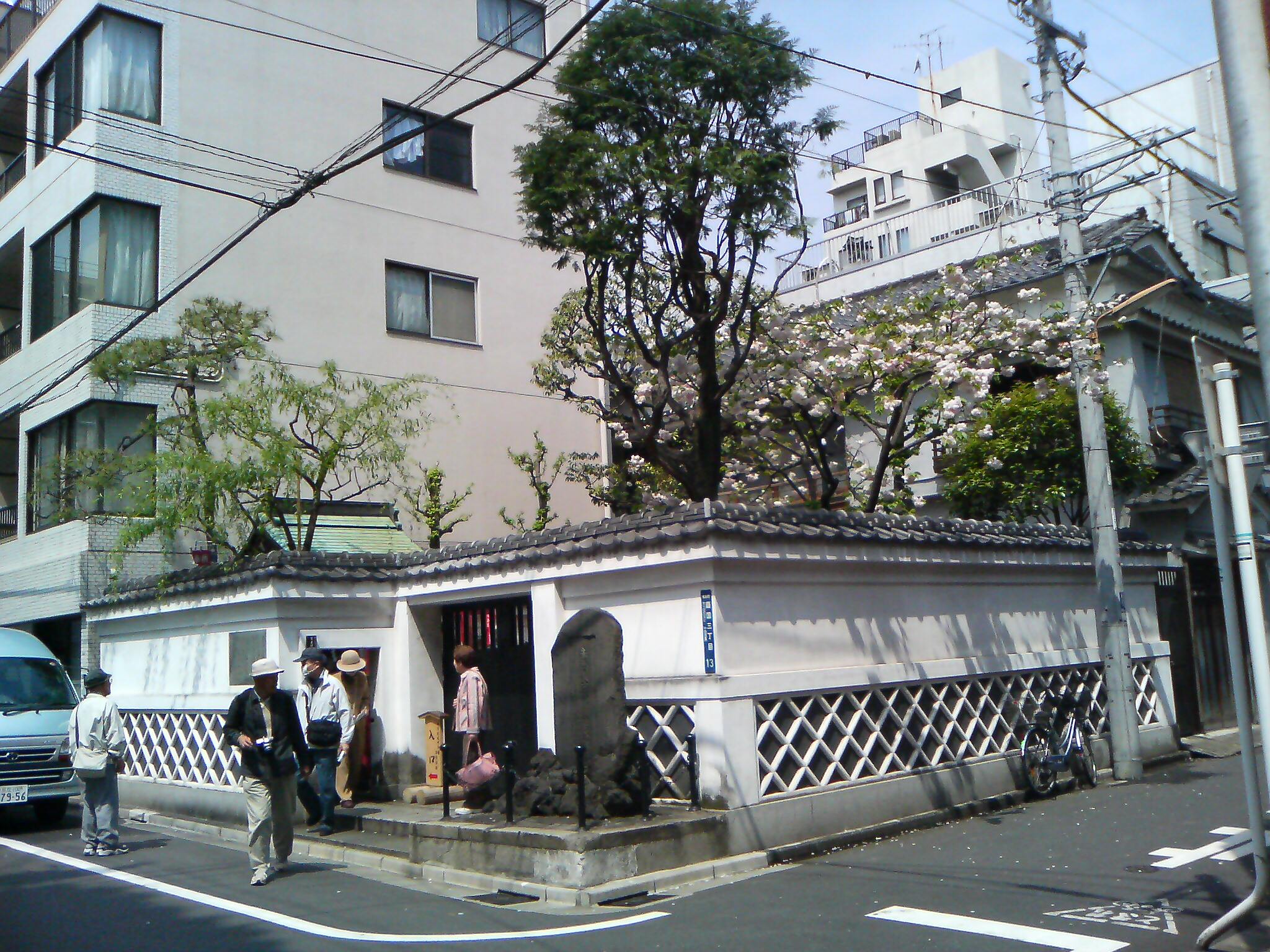
Below is a woodblock printing from 1789 by Katsushika Hokusai illustrating
the Forty-Seven Ronin as they might have descended upon Lord Kira's mansion.

Click here for map location
Below please find
walking directions from the Ekoin shrine to Lord Kira's mansion, where you'll find the remaining two walls that stood as his
gate, and a park with a small garden and memorial inside.
Inside the park is also a well, with a note that this was where Kira's head
was washed before they carried it to Sengakuji Temple.
Once the Ronin arrived at Sengaku-ji temple , they
ritualistically washed Lord Kira's head in the temple's well (pictured below)
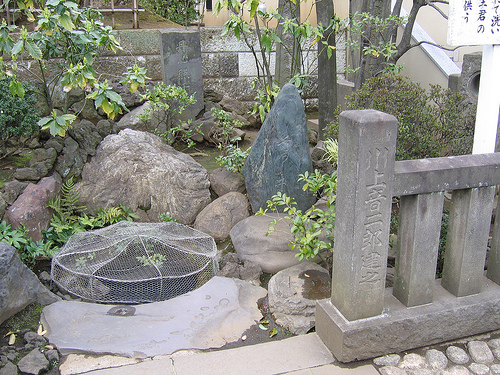
t...then placed Kira's head on their master (Lord Asano)'s grave (pictured
below) along with the dagger Asano used to commit seppuku.
After requesting that the Abbott safely return Kira's head to
his family they each gave him all the money they had to ensure they would receive a proper burial and turned themselves
into the authorities.
Following an investigation, and leaning on the newly found popularity of
the Ronin, the Shogun sentenced each of the men to death by seppuku (self-disembowelment). As this was
an honorable sentence (better than the criminal sentence of decapitation) they accepted this sentence as an honor.
On February 4, 1703 the Forty-Six Ronin successfully committed seppuku and were buried at Sengaku-ji near
Lord Asano.
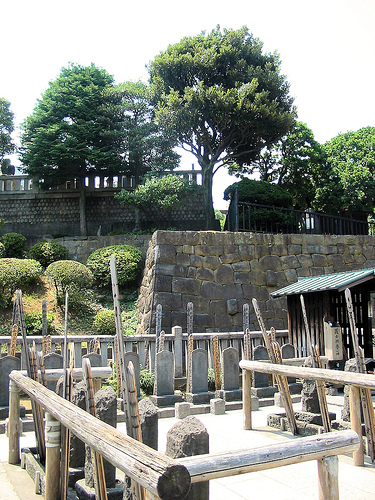
Pictured above are nine of the forty seven ronin graves at Sengaku-ji.
To this
day, you can pay your respects to the forty-seven ronin, see the well that was used for cleaning Kira's head and Asano's grave
where the head was lain and even visit a bronze statue of Oishi Yoshio (leader of the ronin).
The story of the Forty-Seven Ronin was almost instantly a legend. Even on their march from Lord
Kira's palace to Sengaku-ji the news of their heroic deed spread quickly and people stopped them in the
streets along the route to offer them rest and refreshment (pictured below).

Two weeks after the ronin died a play opened telling the mostly true tale
of the ronin (the fable is commonly referred to as "Chushingura"), fictionalized because the names had to be changed
for fear the controversial play would be shut down.
The Ronin became so popular that by the time the Forty-Seventh Ronin returned
from his mission to accept his punishment the Shogun took mercy and pardoned him. When the ronin died of natural causes
at the age of 78, he was honorably laid to rest at Sengaku-ji next to his brethren.
Chushingara continues to be a popular Kabuki play and has been retold in
countless films, tv series and animes. It's Japan's favorite vendetta mostly because it's a glowing example of two
of their favorite qualities loyalty and bravery.
Probably the second most popular story in Japan is the tale of ultimate
loyalty and friendship. The story of Hachiko.
Hachiko ハチ公
Hachiko was a male Akita
dog, born on November 10, 1923 and brought to Tokyo when he was two months old to live with Professor Hidesaburo
Ueno (of Tokyo University). Hachiko (see pic below) was a loyal dog and would follow his master to the
train station (Shibuya) every morning to see him off to work and in the evening he'd arrive at the station in time
to welcome his master back and follow him home.
On May 21, 1925 Dr. Ueno died suddenly during a lecture at the University, but Hachiko arrived at Shibuya
station to wait for his master as he'd done nearly every day of his life for two years. When his master failed to arrive,
Hachiko made the walk back home alone.
Hachiko was given away after his master's death, but he routinely
escaped, showing up again and again at his old home. Over time, Hachi apparently realized that Professor Ueno no
longer lived at the house. So he went to look for his master at the train station where he had accompanied him so many
times before. Each day, Hachiko waited for Ueno to return.
Hachiko became such a permanent fixture at the train station he
attracted the attention of other commuters. Many of the people who frequented the Shibuya train station had seen Hachi
and Professor Ueno together each day. Realizing that Hachiko waited in vigil for his dead master, their hearts
were touched and many brought Hachiko treats and food to nourish him during his wait.
News of Hachiko's remarkable loyalty
eventually made its way outside of Tokyo, and he became something of an iconic figure in Japan. A statue of Hachiko
was commissioned and sculptor Ando Teru completed the task.
Hachiko was in attendance when the statue
was unveiled to cheers at Shibuya station in 1934 (pictured below).

Hachiko became very ill, but despite his hardships he continued to wait.
On March 8, 1935, Hachiko laid down to die in the spot where he had spent
a decade waiting each day for Ueno to come home.
During WWII the decision was made to melt the bronzed statue of Hachiko
to provide metal for the war effort. In 1948, a plan was commissioned to make a new statue, and Ando Teru's son (who
met Hachiko as a child) was commissioned to make the work.
Today, the statue of Hachiko still stands at Shibuya Station
as a symbol of loyalty and friendship. Most Tokyoites (when asked to meet a friend at Shibuya Station) will
know to meet at Hachiko's statue. 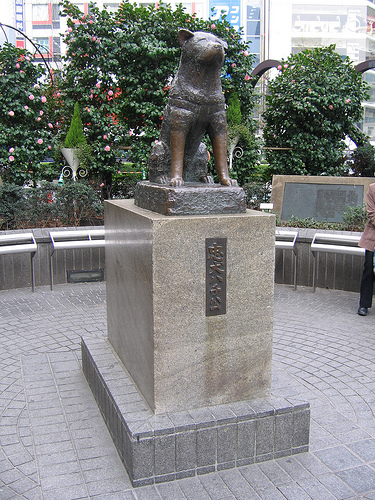
Hachiko's bones were
buried next to his master's grave. His remains were given to a taxidermist whose fine work is lovingly on display at
the National Science Museum in Ueno (pictured below).
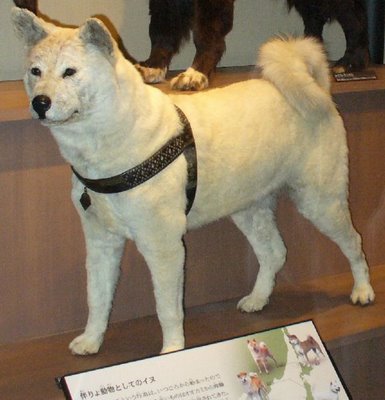
Getting
There - Asakusa - Geisha town and Temple
From Shinjuku
新宿 - Take the Chuo 中央 line to Kanda 神田 and follow signs to the Tokyo Metro
東京メトロ then take the
Ginza Line 銀座線 to Asakusa.
Price: ¥320
Time: 23
minutes
From Nakano
中野 - Take the Chuo 中央 line to Kanda 神田
and follow signs to the Tokyo Metro 東京メトロ then
take the Ginza Line 銀座線
to Asakusa.
Price: ¥370
Time: 27
minutes
Getting
There - Shibuya Station - Hachiko Exit
From Shinjuku
新宿 - Take the Yamanote 山手 line to Shibuya
渋谷 and follow signs to the Hachiko ハチ公 Exit.
Price: ¥150
Time: 7
minutes
From Nakano
中野 - Take the Chuo 中央 line or Chuo-Sobu 中央総武 line to Shinjuku and transfer to the Yamanote 山手 line to Shibuya 渋谷
follow signs to the Hachiko ハチ公 Exit.
Price: ¥160
Time: 15
minutes
Getting
There - Ryogoku - (Sumo Town)
From Shinjuku
新宿 - Take the Chuo 中央 line or Chuo-Sobu 中央総武 line to Ochanomizu 御茶ノ水
and transfer to the Sobu 総武 line to Ryogoku 両国.
Price: ¥210
Time: 17
minutes
From Nakano
中野 - Take the Chuo 中央 line or Chuo-Sobu 中央総武 line to Ochanomizu 御茶ノ水
and transfer to the Sobu 総武 line to Ryogoku 両国.
Price: ¥210
Time: 25
minutes
Click here to see Page Two of Historical Tokyo
Click here to go back to Historic Sites
|
 |
|
|
 |
|
|
 |
|
|
|
|
|
|
 |

